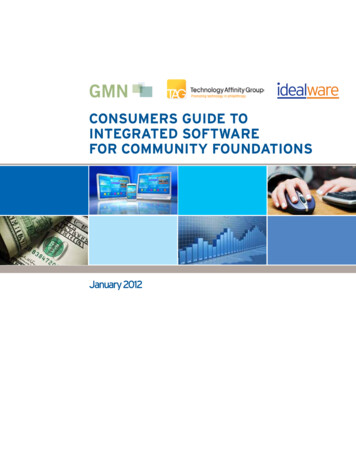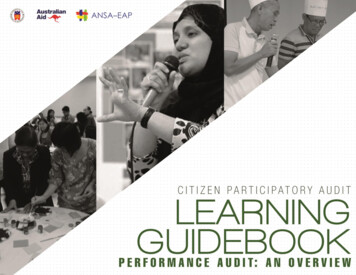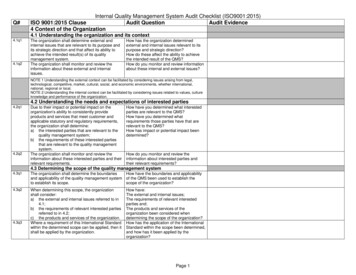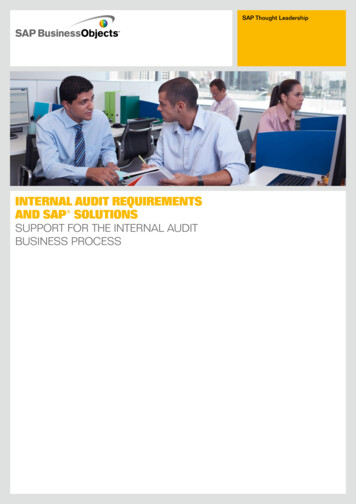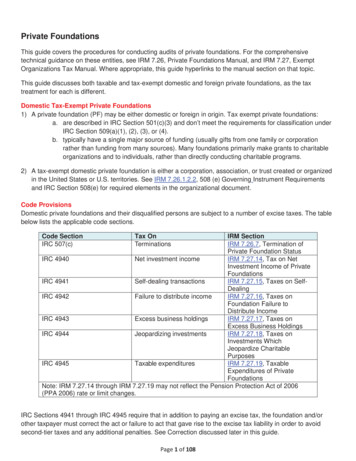
Transcription
Private FoundationsThis guide covers the procedures for conducting audits of private foundations. For the comprehensivetechnical guidance on these entities, see IRM 7.26, Private Foundations Manual, and IRM 7.27, ExemptOrganizations Tax Manual. Where appropriate, this guide hyperlinks to the manual section on that topic.This guide discusses both taxable and tax-exempt domestic and foreign private foundations, as the taxtreatment for each is different.Domestic Tax-Exempt Private Foundations1) A private foundation (PF) may be either domestic or foreign in origin. Tax exempt private foundations:a. are described in IRC Section 501(c)(3) and don’t meet the requirements for classification underIRC Section 509(a)(1), (2), (3), or (4).b. typically have a single major source of funding (usually gifts from one family or corporationrather than funding from many sources). Many foundations primarily make grants to charitableorganizations and to individuals, rather than directly conducting charitable programs.2) A tax-exempt domestic private foundation is either a corporation, association, or trust created or organizedin the United States or U.S. territories. See IRM 7.26.1.2.2, 508 (e) Governing Instrument Requirementsand IRC Section 508(e) for required elements in the organizational document.Code ProvisionsDomestic private foundations and their disqualified persons are subject to a number of excise taxes. The tablebelow lists the applicable code sections.Code SectionIRC 507(c)Tax OnTerminationsIRM SectionIRM 7.26.7, Termination ofPrivate Foundation StatusIRC 4940Net investment incomeIRM 7.27.14, Tax on NetInvestment Income of PrivateFoundationsIRC 4941Self-dealing transactionsIRM 7.27.15, Taxes on SelfDealingIRC 4942Failure to distribute incomeIRM 7.27.16, Taxes onFoundation Failure toDistribute IncomeIRC 4943Excess business holdingsIRM 7.27.17, Taxes onExcess Business HoldingsIRC 4944Jeopardizing investmentsIRM 7.27.18, Taxes onInvestments WhichJeopardize CharitablePurposesIRC 4945Taxable expendituresIRM 7.27.19, TaxableExpenditures of PrivateFoundationsNote: IRM 7.27.14 through IRM 7.27.19 may not reflect the Pension Protection Act of 2006(PPA 2006) rate or limit changes.IRC Sections 4941 through IRC 4945 require that in addition to paying an excise tax, the foundation and/orother taxpayer must correct the act or failure to act that gave rise to the excise tax liability in order to avoidsecond-tier taxes and any additional penalties. See Correction discussed later in this guide.Page 1 of 108
IRC Section 4946 lists definitions for purposes of Chapter 42 excise taxes. See the table below for thosedeemed “disqualified persons.”IRC Section 4946 definitionsSubstantial contributor (SC)Foundation manager (FM)Owner of 20% of entity that is a SCFamily member of the above individualsEntity 35% owned by one of the abovePF with in-common controlling individual(s)(For IRC Section 4943 only)Government official (For IRC Section 4941only)IRM SectionIRM 7.27.20.2, Substantial ContributorGeneralIRM 7.27.20.3, Foundation ManagerIRM 7.27.20.4, Owner of More Than 20Percent Interest of an Organization that isa Substantial Contributor to a FoundationIRM 7.27.20.5, Family Member Within theMeaning of IRC Section 4946(d)IRM 7.27.20.6, Organizations in WhichCertain Disqualified Persons Hold MoreThan a 35 Percent InterestIRM 7.27.20.7, Certain PrivateFoundationsIRM 7.27.20.8, Government OfficialsBy default, all private foundations are deemed non-operating foundations under IRC Section 4942. A privatenon-operating foundation is subject to the excise taxes listed above. The table below lists the exceptions toclassification as a private non-operating foundation. These entities are exempt from certain excise taxes.IRC SectionIRC 4942(j)(3)Type of entityPrivate operatingfoundationIRM SectionIRM 7.26.6, PrivateOperating Foundations IRC Section 4942(j)(3)IRC 4940(d)(2)Exempt operatingfoundationIRM 7.27.14.2.2, ExemptOperating FoundationIRC Sections 4941, 4944, and 4945 impose taxes on foundation managers for knowingly participating intaxable transactions on behalf of the foundation, and for refusing to agree to correction.The PPA 2006, P. L. 109–280, (PPA 2006) changed the Code for Chapter 42 excise taxes. Most of the first-tierexcise taxes and limits on the foundation manager taxes were doubled. The law also substantially modifiedIRC Section 4940, and changes were effective as of the first full tax year that began after August 17, 2006.First-Tier Excise TaxesThe table below identifies the parties subject to the Chapter 42 excise taxes, the applicable tax rates beforeand after the implementation of PPA 2006, and what limit, if any, applies to the tax, and if so, how much.Code SectionLiablepartyTax Rate (PPA2006*)Limit (PPA 2006*)Before AfterBeforeAfterIRC 4940(a)PFup to 2% up to 2% NoneNoneIRC 4941(a)(1)Selfdealer5%None10%Page 2 of 108None
IRC 4941(a)(2)FM2.5%5% 10,000per act 20,000 per actIRC 4942(a)PF15%30%NoneNoneIRC 4943(a)(1)PF5%10%NoneNoneIRC 4944(a)(1)PF5%10%NoneNoneIRC 4944(a)(2)FM5%10% 5,000 per 10,000 per actactIRC 4945(a)(1)PF10%20%NoneIRC 4945(a)(2)FM2.5%5% 5,000 per 10,000 per actactNone*The tax rate changes are effective for full tax years that begin after August 17, 2006.If an organization or individual incurs an excise tax under 4941, 4942, 4943, or 4944 in a given year, then thefirst-tier tax is imposed that year and each subsequent tax year or partial year in the taxable period (under4943, only for tax years that end within the taxable period). The taxable period doesn’t end until the earliest of:a. full correction,b. assessment, orc. issuance of a notice of deficiency. The notice of deficiency should reflect taxes owed for allyears and partial years up to the date of notice, as a second notice of deficiency might not beallowed for taxes on the same act or failure to act (IRC Section 6212(c)).Under IRC Section 4945, there is only one first-tier tax in the taxable period (unlike IRC Sections 4941 - IRC4944).Use the tax year of the disqualified person for IRC Section 4941 (Rev. Rul. 75-391, 1975-2 C.B. 446).Except for IRC Section 4940, excise taxes are reported on Form 4720, Return of Certain Excise Taxes UnderChapters 41 and 42 of the Internal Revenue Code. For taxes on individuals, convert the Form 4720 to a Form4720-A by writing “-A” after the 4720 on the top of the form.To compute IRC Section 4940 and IRC Section 4942 taxes, complete the Form 990-PF, Return of PrivateFoundation or Section 4947(a)(1) Trust Treated as Private Foundation. Reclassify expenditures as necessaryto determine the qualifying distributions. (IRM 7.27.14.2.3.4, Qualifying Distribution and IRM 7.27.16.3.2,Qualifying Distributions Defined.)The applicable report forms are:xxxxForm 4621, Exempt Organizations - Report of ExaminationForm 4883, Exempt Organizations Excise Tax Audit ChangesForm 886-A, Explanation of ItemsForm 870-E, Waiver of Restrictions on Assessment and Collection of Deficiency andAcceptance of OverassessmentPage 3 of 108
IRC Section 4940: Net Investment IncomeThis subsection focuses on:xxxtax law updatestax calculationstax assessmentsSee IRM 7.27.14 for the comprehensive technical discussion of IRC Section 4940. Note: There is no secondtier tax for IRC Section 4940.For IRC Section 4940, PPA 2006 makes clear that for taxable years beginning after enactment, grossinvestment income includes income (other than unrelated business taxable income (UBTI)) from and fromsources similar to:xxxxxinterestdividendsrentspayments with respect to securities loans (IRC Section 512(a)(5))royalties (including overriding royalties)The law also changes how capital gains and losses are treated so that all capital gains and losses (other thanUBTI, if applicable) are included in gross income, with a specific exception for like-kind exchanges of relateduse property. The law also:xxprohibits including carrybacks or carryovers of capital losses in computing gross investmentincome.redefines capital gain net income to include property used for the production of grossinvestment income.Calculate net investment income using a series of simple calculations. See the tables below for the basicformulas to compute the tax.TermEquationNet investment income Gross investment income Pluscapital gain net incomeLess allowable deductionsCapital gain net income* Capital gainsLess capital losses*** Capital losses can’t exceed capital gains (i.e. no net capitallosses.)**Capital losses can’t be carried forward or back.Complete the Form 990-PF, Part I to ensure that you include all of the appropriate income and deductions.Page 4 of 108
There are several possible tax rates applicable under IRC Section 4940:xxx0 Percent1 Percent2 PercentTo use a 0 percent tax rate, a foundation must be a private operating foundation under IRC Section 4942(j)(3)that meets the requirements, for the tax year in question, of an exempt operating foundation under IRC Section4940(d). See IRM 7.27.14.2.2.To use a 1 percent reduced tax rate, a foundation must meet IRC Section 4940(e) requirements. Complete theForm 990-PF, Parts X, XI, XII, and V to determine eligibility for the reduced rate. This typically requires redoingthe Form 990-PF for the prior five years. If you determine that Part V Line 8 is less than Part V Line 7, due toreclassifying expenses or disqualifying distributions, the foundation is subject to the 2 percent rate.The tax is reported on Form 990-PF. Any adjustments to the tax are made to the Form 990-PF. Use Forms4621 and 4883 to propose any changes in the IRC Section 4940 tax. Use Form 870-E to secure agreement.See Exhibit 1 for an example of how to compute the tax and complete the Forms 4883 and 4621.IRC Section 4941: Self-DealingSee IRM 7.27.15 for the comprehensive technical discussion of IRC Section 4941. This subsection focuses onhow to calculate and assess the tax once you’ve determined that a self-dealing transaction has occurred.IRC Section 4941 taxes are imposed for every year or partial year within a taxable period. The taxable periodstarts with the self-dealing act and ends with the earlier of:xxxcorrectionissuance of a statutory notice of deficiencyassessment of the excise taxIRC Section 4941 self-dealing transactions are classified as discrete or continuing. Taxes for discretetransactions are imposed for each year/partial year in the taxable period. Taxes for continuing transactions areimposed for each year/partial year in the taxable period, and are deemed to create new transactions on thefirst day of each subsequent taxable year in the taxable period. (See Treas. Reg. 53.4941(e)-1(e)(1))Continuing transactions “pyramid” the tax liabilities but generally have a lesser “amount involved” than discreteacts. The table below lists the transactions that are generally considered to be discrete or continuing,respectively.Type of transactionDiscrete or continuingtransactionSale of property to/from a DPDiscreteExchange of property with a DPDiscreteLeasing of property to/from a DPContinuingLending of money to/from a DPContinuingPage 5 of 108
Other extension of credit to/froma DPContinuingFurnishing of goodsDiscreteFurnishing of servicesDiscreteFurnishing of facilitiesDiscrete (Unless leasingof property)Payment of compensationContinuingTransfer of a PF asset to a DPDiscreteUse of a PF asset by a DPContinuingUse of a PF asset for the benefitof a DPContinuingAgreement to make payment togovernment officialDiscreteNote: See Treas. Reg. 53.4941(e)-1(e)(1)(i) for the list of acts that are generally treated as“continuing”.The following examples illustrate the concept of discrete and continuing transactions.Example: Discrete: A substantial contributor to a foundation buys back a piece of artwork originally donated tothe foundation. The payment is made on December 30, 2015. The foundation and contributor are calendaryear taxpayers. No correction was made or tax assessed or notice of deficiency mailed until January 1, 2017.The contributor will owe tax on the transaction in 2015, again in 2016, and again in 2017. The table belowillustrates the discrete concept:Date20152016201712/30/2015XXXExample: Continuing: A substantial contributor donates a painting to the foundation on January 17, 2015. Thecontributor then hangs the painting in his or her study in their home on the same day. No correction was madeor tax assessed or notice of deficiency mailed until January 1, 2017. The foundation and contributor arecalendar year taxpayers. The contributor will owe tax on the use of the painting in 2015, 2016, and 2017. Inaddition, the contributor is deemed to have a new transaction on January 1, 2016, and again on January 1,2017. The table below illustrates the continuing (“pyramiding”) 2017XThere are exceptions to the rules for self-dealing. See IRM 7.27.15.4.2.Page 6 of 108
Due to the nature of a transaction, the amount involved in a transaction is determined differently based on thetype of transaction. The general rule is that the amount involved is the greater of:xxthe fair market value of the property giventhe fair market value of the property receivedThis rule is modified for the use of money or property, where the amount involved is the greater of:xxthe amount paid for such usethe fair market value of such usefor the period for which the property is used. Other modifications may also apply. See IRM 7.27.15.7.1, AmountInvolved, Reg. 53.4941(e)–1(b), and Treas. Reg. 53.4941(e)-1(b).Example: A private foundation sells a condominium to its founder. The condo’s fair market value is 250,000.The founder pays 25,000. The amount involved under the general rule is the greater of 250,000 or 25,000.In this case, the amount involved is 250,000. This amount is subject to the self-dealing tax.Example: On July 1, 2014, a child of a substantial contributor moves into a foundation owned apartmentcomplex to attend a nearby college. The child lives rent free in the apartment for six months of 2014, all of2015, and all of 2016 until correction is made December 31, 2016. The next-door neighbors in an identicalapartment pay 700 per month in rent in 2014, 750 in rent in 2015, and 800 in rent in 2016. The foundationand the child are calendar year taxpayers. The act triggers separate deemed acts on January 1, 2015, andJanuary 1, 2016. The amount involved in each year is as follows:Amount Involved700.00Time inMonthsx6 1/1/2015750.00x 12 9,000.001/1/2016800.00x 12 9,600.00DateRent Amount7/1/20144,200.00Refer to the Correction section for a discussion of acceptable correction.See Exhibit 2 through Exhibit 6 for examples of how to compute the tax and complete the Forms 4883 and4621. Prepare Form 870-E.The tax is reported on Form 4720-A, assessed against the self-dealer(s), and if applicable, the foundationmanager(s). See IRM 7.25.22, EO Delinquent, Amended and Substitute for Return Procedures, for setting up asubstitute for return or securing a delinquent return.IRC Section 4942: Failure to DistributeSee IRM 7.27.16 for the technical discussion of IRC Section 4942. This subsection focuses on how to calculateand assess the tax once you’ve determined that the foundation has failed to meet its distribution requirements.IRC Section 4942 taxes don’t pyramid like continuing acts of self-dealing, but a failure to distribute in a givenyear may give rise to tax in multiple years in the taxable period like discrete acts of self-dealing. Also, if there isa failure to distribute in one year, there may be a failure to distribute in subsequent years. IRC Section 4942may be triggered when you disqualify an otherwise “qualifying distribution.”Page 7 of 108
Qualifying distributions are made to achieve IRC Section 170(c)(2)(B) purposes. IRM 7.27.16.5 outlines theways in which distributions are deemed to qualify.If you determine that a distribution doesn’t serve an IRC Section 170(c)(2)(B) purpose, and doesn’t meet anexception in IRC Section 4942 or in Treas. Reg. 53.4942(a)-3, then redo the Form 990-PF Parts X, XI, XII, andXIII for the year(s) under audit. If operating under a six-year statute memo from Area Counsel, redo the formfor each year under audit.Note: Some transactions that constitute self-dealing transactions and/or taxable expenditures aren’t qualifyingdistributions. Look at each transaction/expenditure on a case by case basis.A taxpayer generally can’t make any elections with respect to qualifying distributions during your audit. Theymust make the elections before they file the Form 990-PF. If the taxpayer properly made a pre-filing election,verify it. If there is a valid election, consider that in your revised Part XIII. (You may find the election in anotherpart of the form.)Refer to the Correction section for a discussion of acceptable correction.Complete Forms 4883, 4621, 886-A and 870-E. See Exhibit 7 and Exhibit 8 for examples of computing andproposing the tax. Note that to incur the tax requires two years of failing to distribute; in other words, afoundation has until the end of Year 2 to make qualifying distributions of its distributable amount for Year 1.Consider opening all periods with open statutes when dealing with possible disqualified distributions.The tax is reported on Form 4720 and assessed against the private foundation. See IRM 4.75.22, EODelinquent, Amended and Substitute for Return Procedures, to set up a substitute for return or secure adelinquent return.IRC Section 4943: Excess Business HoldingsFor the comprehensive technical discussion of IRC Section 4943, see IRM 7.27.17. This subsection focuseson how to calculate and assess the tax once you’ve determined that the foundation has exceeded its permittedbusiness holdings.IRC Section 4943 taxes, like discrete acts of self-dealing and 4942 taxes, are imposed for the year in which thefoundation has excess business holdings and each subsequent year in the taxable period. The amount of taxmay vary from year to year as the excess holdings vary.The foundation may hold an ownership interest in a business enterprise. The foundation is permitted to hold upto:xxx2%, regardless of disqualified person ownership percentages (de minimis rule)35% (ownership of foundation and disqualified persons combined), if the enterprise is effectivelycontrolled by third persons. (See Rev. Rul. 81-111, 1981-1 C.B. 509.)20% (ownership of foundation and disqualified persons combined), in all other cases.Caution: Pay particular attention to the source of the income in the business enterprise. If 95 percent or moreof the gross income is from passive sources, then the above rules don’t apply, as a passive holding companyis not considered a business enterprise. Passive sources include but are not limited to interest, dividends,payments with respect to securities loans, royalties, and rent from real property. (IRC Sections 4943(d)(3)(B),IRC 512(b)(1), IRC 512(b)(2), and IRC 512(b)(3)).Page 8 of 108
Foundations in many instances have a grace period to divest itself of the excess ownership interest, whichvaries depending on the circumstances. In general, the foundation has five years in which to dispose of excessholdings acquired other than by purchase without incurring any tax. There are exceptions to the rule, such as a90-day time limit in certain situations. See IRM 7.27.17.5, Five-Year Disposition Period.When examining a private foundation, verify the amount of ownership in any business enterprise. Perform thirdparty contacts with the disqualified persons as needed to determine their ownership percentages. Issuesummonses as needed if the disqualified persons are uncooperative.Note: Be aware that some business enterprise holdings may also constitute jeopardizing investments.If there are excess business holdings, determine for how long the foundation has had the excess holdings.Review IRM 7.27.17.5 to determine the applicable grace period for disposing of the holdings. If the foundationhas exceeded the applicable period, calculate and propose the tax on the foundation.For purposes of the tax calculation, determine the highest value of the holdings within the tax year. If theownership interest is in a privately held company or partnership, determine whether to make a SpecialistReferral System referral for a Large Business and International (LB&I) economist or engineer. The tax is on thefair market value of the excess portion of the business holdings for the tax year. Assess the tax for each yearfor which the foundation has/had excess holdings.Consider expanding your audit to additional years for which the statute is open, and for which the foundationstill had excess holdings as of the start of the tax year. The tax amount may vary per year, depending on theincrease/decrease in excess holdings that occurred in the years under audit.Refer to the Correction section for a discussion of acceptable correction.Complete Forms 4883, 4621, 886-A and 870-E. See Exhibit 9 and Exhibit 10 for examples of how to determineand compute the tax.The tax is reported on Form 4720 and assessed against the private foundation. See IRM 4.75.22, EODelinquent, Amended and Substitute for Return Procedures, to set up a substitute for return or secure adelinquent return.IRC Section 4944: Jeopardizing InvestmentsSee IRM 7.27.18 for the technical overview of IRC Section 4944. This subsection focuses on how to identifyliability for, calculate, and assess the tax once you’ve determined that the foundation possesses jeopardizinginvestments.Investment in a Ponzi scheme may potentially trigger IRC Section 4944, depending on the facts andcircumstances. If you find that the foundation invested in a Ponzi scheme, consult with Area Counsel.Look for investments that show a lack of reasonable business care and prudence in providing for thefoundation’s long and short term financial needs for it to carry out its exempt function. No single factordetermines a jeopardizing investment.No specific category of investments is treated as a violation, however, apply careful scrutiny to:xxxxTrading in securities on marginTrading in commodity futuresInvesting in working interests in oil and gas wellsBuying puts, calls, and straddlesPage 9 of 108
xxBuying warrantsSelling shortIf the investment decision was sound at the time the investment was made, it’s not a jeopardizing expense,even if it later results in a loss.Keep in mind that the tax doesn’t apply to investments:xxxOriginally made by a donor who gifted them to the foundation*Acquired by the foundation as a result of a corporate reorganizationMade before 1970**Exception: * If the person receives any consideration from the foundation on the transfer, the foundation istreated as having made an investment equal to the consideration.Exception: ** If the form or terms of the investments are later changed, or they are exchanged for otherinvestments, then the investments can be subject to the tax.Compute the tax using the value of the amount invested on the day the investment was made. Assess the taxfor each year or partial year in the taxable period. The tax amount is the same for each year, like discrete actsof self-dealing and 4942 and 4943 taxes.In addition to the IRC Section 4944(a)(1) tax imposed on foundations, IRC Section 4944(a)(2) provides for atax on the foundation manager who knowingly and willfully participates in the investment. See IRM 7.27.18.6.2,First-Tier Tax on Foundation Managers, for the required criteria to propose the tax.Refer to the Correction section for a discussion of acceptable correction.Complete Forms 4883, 4621, 886-A and 870-E. See Exhibit 11 and Exhibit 12 for examples of how todetermine and compute the tax.The IRC Section 4944(a)(1) tax is reported on Form 4720 and assessed against the private foundation. SeeIRM 4.75.22, EO Delinquent, Amended and Substitute for Return Procedures, to set up a substitute for returnor secure a delinquent return.The foundation manager tax is reported on Form 4720-A and assessed against the responsible individual(s).IRC Section 4945: Taxable ExpendituresSee IRM 7.27.19 for the technical discussion of IRC Section 4945. This subsection focuses on how to identifyliability for, calculate, and assess the tax once you’ve determined that the foundation made taxableexpenditures.IRC 4 Section 945(d) lists five categories of taxable expenditures. These include amounts:1) Spent to carry on propaganda or attempt to influence legislation. IRC Section 4945(d)(1)2) Expended to influence any specific public election outcome, or to carry on a partisan voterregistration drive (directly or indirectly). IRC Section 4945(d)(2)3) Paid as a grant to an individual for travel, study, or other similar purposes, unless satisfiesSection 4945(g). IRC Section 4945(d)(3)4) Disbursed as a grant to an organization, unless the organization is a public charity (other thancertain supporting organizations) or the PF exercises expenditure responsibility per IRC SectionPage 10 of 108
4945(h). See IRC Section 4945(d)(4)(A)(ii)) or exempt operating foundation. IRC Section4945(d)(4)5) Paid or incurred for any purpose other than one in IRC Section 170(c)(2)(B). IRC Section4945(d)(5)For the required elements of and exceptions for each category, see the following IRM sections:xxxxxFor IRC Section 4945(d)(1), see IRM 7.27.19.3, Attempting to Influence Legislation (Lobbying)For IRC Section 4945(d)(2), see IRM 7.27.19.4, Public Elections and Voter Registration DrivesFor IRC Section 4945(d)(3), see IRM 7.27.19.5, IRC 4945(d)(3) Grants to IndividualsFor IRC Section 4945(d)(4), see IRM 7.27.19.6, Grants to Organizations IRC Section 4945(d)(4)For IRC Section 4945(d)(5), see IRM 7.27.19.7, Expenditures for Noncharitable Purposes IRCSection 4945(d)(5).An expenditure may fall into several categories of taxable expenditure. Regardless of the number of categoriesviolated, the tax is assessed only once.Example: A foundation manager issues a series of payments to two individuals to travel throughout severalcounties in a state during an election year. The recipients act as paid signature gatherers for a number of ballotinitiatives to modify current laws. They also go door to door to sign up eligible voters, based on a list ofpotential voters provided by a state political party. They provide pamphlets to the voters promoting specificparty candidates. The individuals submit travel vouchers for reimbursement to the foundation, along with thesignature pages, lists of voter registrations, and paid invoices for the printing of the pamphlets.Note: In the above example, the foundation has violated IRC Sections 4945(d)(1), (d)(2), and (d)(5). Thefoundation is liable only once for the tax on the reimbursements to the individuals, and the tax is imposed onlyonce in the taxable period.When examining the foundation, review all of the expenditures. Determine which expenditures constitutegrants. For grants to individuals for travel, studies, or similar purposes, verify that the organization hasobtained an IRC Section 4945(g) advance ruling letter. The organization may request the letter during the initialapplication process or in a subsequent ruling request. If the foundation doesn’t have a ruling letter, determinewhether it meets an exception under IRC Section 4945(d)(3) (IRM 7.27.19.5) or IRC Section 4945(g) (IRM7.27.19.5.7, Advance Approval Under IRC 4945(g)). Assess the tax if the foundation doesn’t meet theexceptions.Note: The foundation may submit Form 8940, Request for Miscellaneous Determination, and pay a user fee torequest an IRC Section 4945(g) advance ruling letter. The ruling is prospective from the date of the letter andis not retroactive, though it may be required as part of correction.Unless a grant was made to a public charity (other than certain supporting organizations - see IRC Section4945(d)(4)(A)(ii)) or an exempt operating foundation, determine whether the foundation exercised expenditureresponsibility. See IRM 7.27.19.6.5, Expenditure Responsibility. Review the:xxxxPre-grant inquiries (IRM 7.27.19.6.6, Pre-grant Inquiry Requirement IRC Section 4945(h)(1))Grant agreements (IRM 7.27.19.6.7, Terms of Grant Agreements)Grantee reports (IRM 7.27.19.6.10, Reporting Requirements of the Grantee Organization)Grantor reports (IRM 7.27.19.6.11, Reporting Requirements of the Grantor)For those grants that failed the expenditure responsibility requirement, propose the first-tier tax and requestcorrection. Refer to the Correction section for a discussion of acceptable correction.Page 11 of 108
Be aware that there are permitted expenditures, such as:xxxxxxxxExpenditures to acquire investments that generate income to be used to further the purposes ofthe organization.Reasonable expenses related to acquiring these investments.Payment of taxes.Expenses that qualify as allowable deductions in figuring unrelated business income tax (UBIT).Any payment that is an IRC Section 4942 qualifying distribution.Any deduction allowed in arriving at taxable net investment income (IRC Section 4940).Reasonable expenditures to evaluate, acquire, modify, and dispose of program-relatedinvestments.Business expenses of the recipient of a program related investment.Payment of unreasonable administrative expenses, including wages, consultant fees, and other fees forservices performed, are taxable expenditures unless they were:a) Made in the good faith belief that the amounts were reasonable.b) Consistent with ordinary business care and prudence.Request documentation that supports the reasonableness determination for any expenditure that appearsunreasonable. Expenditures may be taxable if the trustees, officers, or foundation managers didn’t make aneffort to determine whether the expenditures were reasonable. If needed, submit a Specialist Referral Systemrequest for an LB&I engineer to evaluate the expenditure. Determine the excess expenditure and propose thetax for the excess amount.Compute the tax using the expenditure amount, or excess amount i
Private Foundations This guide covers the procedures for conducting audits of private foundations. For the comprehensive technical guidance on these entities, see IRM 7.26, Private Foundations Manual, and IRM 7.27, Exempt Organizations Tax Manual. Where appropriate, this guide





